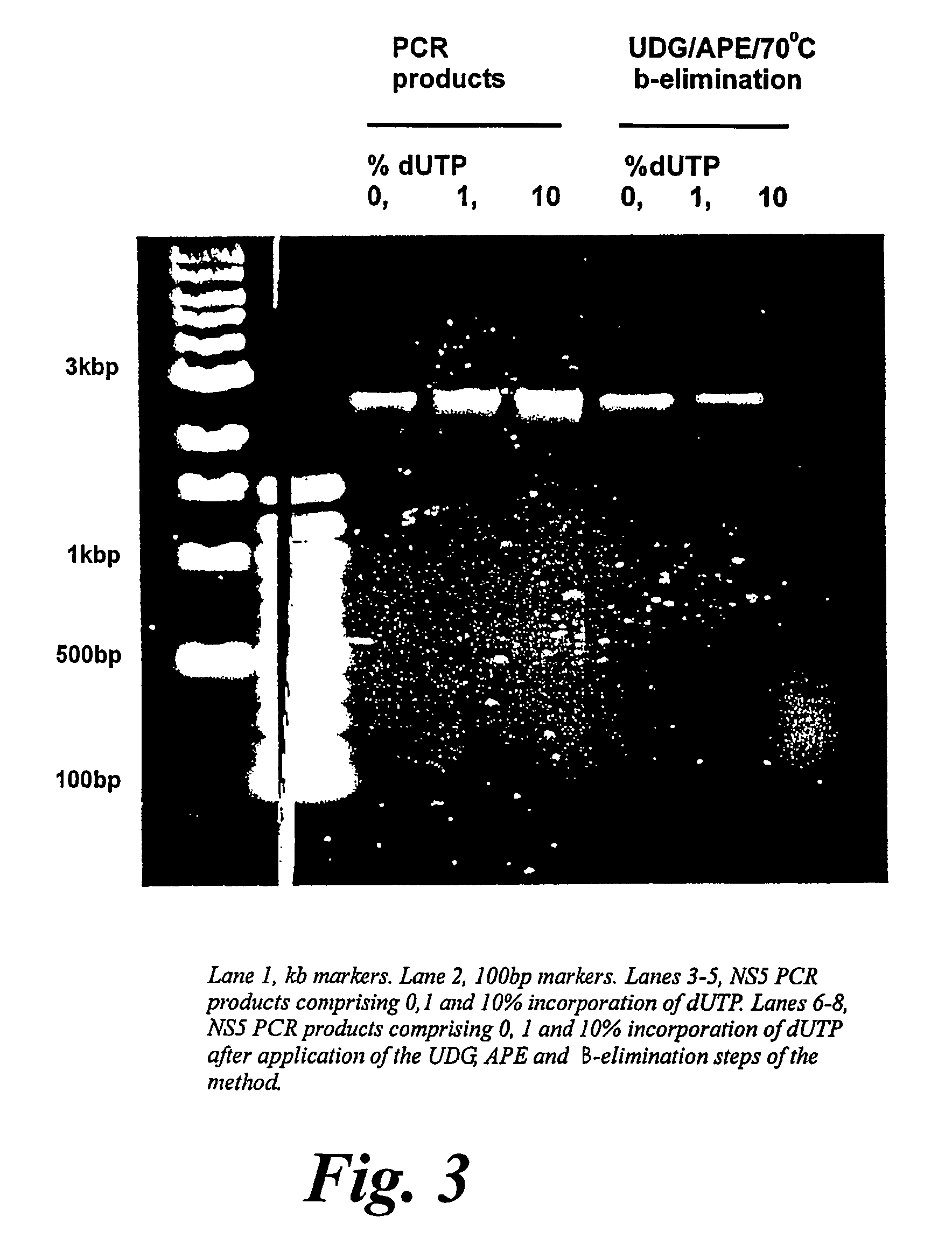[0022] The method for generating random gene fragments involves random incorporation of a non-native
nucleotide into the product
nucleic acid sequence, in place of a native
nucleotide, at a frequency that is preferably determined by the
molar ratio of non-native to native
nucleotide used in preparation of the coding sequence. The amplified nucleic acid product is then preferably contacted with a
reagent capable of recognising and cleaving the sequence at the non-native nucleotide, for example by using an
enzyme such as
a DNA glycosylase or
endonuclease, which can recognise the presence of the non-native nucleotide and cleave the
nucleic acid sequence at or around the non-native
nucleic acid sequence. A preferred protocol employs
enzyme(s), β-
elimination and temperature changes in order to generate DNA fragments derived by essentially unbiased sampling and predominantly of defined size range. The method of the present invention is particularly advantageous as it allows the production of nucleic acid fragments of a size which
encode protein domains of the polypeptide, e.g. preferably between 100 and 1500 nucleotides, more preferably between 200 and 1200 nucleotides, and most preferably between 300 and 1000 nucleotides in length, and is capable of fine sampling of the nucleic acid encoding the polypeptide, producing fragments on average every second nucleotide. In order to allow generic application for library sampling of any polypeptide it may be advantageous to re-code certain nucleotide sequences to contain more incorporation sites for the non-native nucleotide, up to the limits imposed by the constraints of the
genetic code.
[0024] Thus, in a preferred embodiment, the present invention provides a method of producing fragments of a desired polypeptide, the method comprising expressing the nucleic acid sequences encoding fragments of the desired polypeptide and optionally isolating the polypeptide fragments thus produced. Preferably, the polypeptide fragments are expressed as fusions with an affinity tag, so that they can be purified by
affinity chromatography. Preferably,
peptide based affinity tags will be less than 25
amino acid residues long, and more preferably less than 15 residues long. Preferred affinity tags have
minimal effect on the
solubility, stability and / or aggregation state of the attached
protein fragment. The use of C-terminal affinity tags is preferred as this permits the selection of clones that express in-frame fragments of DNA, while DNA fragments which are out-of-frame would tend to terminate prior to the translation of the tag.
[0031] Preferably, this method makes use of non-native nucleotides, and in particular non-native nucleotide bases that can be randomly incorporated into the DNA duplex and then selectively excised to produce the nucleic acid fragments of the polypeptide. None of the current enzymatic methods reviewed above, that aim to produce DNA fragments of essentially random distribution with respect to the source DNA (e.g. DNAase 1
digestion), provide
robust control of
fragment size range or sampling of DNA in a manner fully independent of DNA secondary structure, or robust reproducibility. In contrast, the
present method preferably provides fine sampling with cleavage every second nucleotide on average,
robust control of
fragment size range, rapid and facile execution, and robust reproducibility. The DNA produced by the method is also compatible with blunt ended and
TA cloning methods for construction of expression vectors.
[0034] This
DNA fragmentation method has several advantages over other possible methods. Firstly, given pure
reagent enzymes, every enzymatic step can be allowed to go to completion, so that the size distribution of the fragments generated, is dictated solely by the TTP / dUTP ratio used in the original PCR reaction. This is in contrast to other
enzymatic digestion approaches such as: cleavage by endonucleases (eg. DNAase I) that cleave both strands of duplex DNA, which fully degrade DNA to free nucleotides if the
digestion is allowed to go to completion. Computer simulations of the
present method using a 5120
base pair gene suggest that a TTP / dUTP ratio of 100:1 will give even cover of the coding sequence, and good representation of fragments in the desired ‘domain’ size range (˜300-1000 nucleotides). Secondly, all the procedures involved are enzymatic and therefore carried out under ‘mild’ conditions that will cause no other
DNA damage, and are completely compatible with rapid efficient DNA
purification methods such as
ion-exchange and silica-based adsorption methods that may be used between subsequent steps. Thirdly, the products of these reactions are fully ‘biological’ and suitable for
cloning into expression vectors by blunt-end
ligation or TOPO-
isomerase I-mediated
ligation.
[0036] In many circumstances, it will be desirable to generate ‘ragged-terminus’ libraries in which, for example,
a domain such as an N-terminal domain is always present, but a wide range of C-termini are to be sampled. This can be readily achieved using the method by performing two PCR steps and a
thermal denaturation and annealing step: 1) amplification of the constant 5′-segment encoding the N-terminus in a TTP PCR reaction; 2) amplification of a 3′ segment that partially overlaps with the 5′ segment in a TTP / dUTP PCR reaction; 3) and then mixing the products of these two PCR reactions before thermal melting and re-annealing. A restriction
endonuclease (RE) site, that generates a “sticky-ended” on cleavage, may be introduced into the 5′ extremity of the 5′-segment, so that the library of N-terminally constant but C-terminally ragged coding sequences can then be efficiently cloned into a vector cleaved the above RE and another with a second RE that generates a blunt end.
[0043] In this aspect of the present invention, the nucleic acid fragments is introduced into an
expression vector(s) to produce a library of different DNA fragment expression constructs and
protein expression is induced and the derived protein then treated in a novel approach that selectively removes insoluble and / or soluble misfolded and / or non-specifically aggregated protein fragments allowing selective detection and purification of the soluble folded unaggregated or specifically aggregated protein fragments.
 Login to View More
Login to View More 


